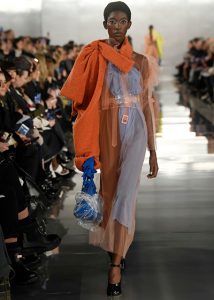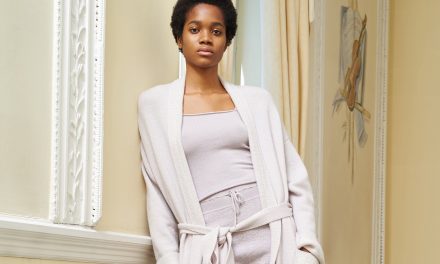Autumn Winter 20 Catwalk Report
Upcycling was the unexpected order of the day at the Autumn Winter shows for 2020. Amidst the twin threats of climate crisis and the spread of COVID-19, we ask what was relevant about this seasons fashion weeks.
It’s a wild, wild time. And now that we are reflecting on Fashion Week in retrospective, we can say that the general spirit that emerged from the last round of fashion weeks has been visionary. This fashion month was followed by protests and several shows closed to the public due to precautionary measures for the COVID-19 spread, only added to the underlying sense of tension. Even though there are now more questions raised than ever with two emergencies overlapping, the climate crisis and what COVID-19 will mean to the fashion industry, it’s important to take a step back. We can analyse what happened during the hectic fashion month, and try to recontextualise that into what is now a moment of confusion and frustration, but also – potentially and hopefully – disruption for the better.
New York
It all started in New York at The Vendeur’s favourite Gabriela Hearst’s show. The refreshingly wearable and perfectly tailored collection saw a colour palette that screamed ‘Autumn’ (Camel, Burgundy, Navy, shades of golden Okra). It showcased repurposed looks, including a trench coat and peacoat made from Turkish Kilim remnants, and two riding coats reconstructed from existing outerwear.
Elsewhere in NYC, Alice + Olivia teamed up with Zero Waste Daniel. This clothing brand produces fashion with no wasteful byproducts. The collection was zero waste, challenging the norms of the usually wasteful industry and preventing excess textile from going into landfill.

London
Even though there’s still a long way to go, London Fashion made us pretty proud this season. It’s probably the fashion capital that shows a collective conversation on sustainability the most, especially in the midst of the Extinction Rebellion protests that accompanied the entries of the fashion shows. The movement had asked the BFC (British Fashion Council) to cancel London Fashion Week to “immediately start work on an emergency action plan that aids stakeholders through change”. It’s in this climate that Patrick Mcdowell had the provocative yet smart idea of holding a swap shop in collaboration with Global Fashion Exchange (Mr Patric Duffy) and the British Fashion Council.

Richard Malone, who is now an established voice in the sustainability panorama, announced he will no longer be introducing collections every season. He accompanied the statement with the details of his label’s practices with full transparency, right down to the hourly rates (a minimum of £25 per hour) for the local cutters and tailors that he employs. It was a bold statement that declared that ethical fashion is possible, a better future is not utopia.
But what has also been reassuring, (better late than never if you ask us), was to see the iconic and established fashion brands reconsider their approach to production, design and consumption. Burberry, revealed in 2018 to have incinerated $37 million of product, changed it;s stripes and ran a carbon-neutral runway show. They also announced their Regeneration Fund: a series of ‘carbon insetting’ projects which will be implemented within their supply chain.
Milan
At Milan Fashion Week Emporio Armani closed his fashion show to the public and launched his R-EA (Recycled Emporio Armani) collection. At the end of the show, he presented looks created from recycled, regenerated or organic materials. Marni featured patchwork and collaged pieces recreated with juxtaposed scraps of fabrics, repurposed from deadstock materials. Meanwhile John Galliano’s collection for Maison Margiela repurposed upcycled material the couture way with its new collection, “Recicla”. Thrifted from second hand stores and flea markets, the designer created works of art that will also be available to purchase.

Paris
Another talent that’s busy showing us how it’s done is the hip Parisian namesake label of Marine Serre. After invading every fashion aficionado Instagram’s feed with her designs and moon prints, she came back to say she’s not a meteor but a thoughtful brand that is here to stay. Her garments were 50% upcycled using leather and fake fur bedspreads to construct her outerwear, with lace-trimmed tablecloths.

We eagerly awaited sustainability veteran Stella McCartney’s show and she did not disappoint. The designer and environmentalist gave baby trees to her guests at her fashion show, in paper bags that said: “We should all be carbon-neutral now”. The same ‘animals’ that distributed the press gifts then took part of a joyful finale. The future holds many uncertainties, and we can try to grasp how the future of fashion will look only one step at a time. In this overall chaos, we want to go back to that wonderful finale, and remind ourselves that we are still part of a bigger system. That nature, and everything else, has its own course.
Disclaimer: The people and models in the images featured are not associated with The Vendeur and do not endorse it or the products shown. This post may contain affiliate links. Prices correct at time of publishing.





Trackbacks/Pingbacks